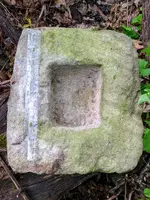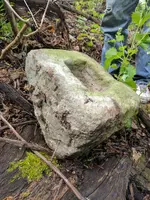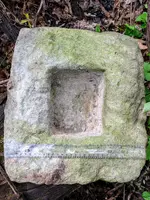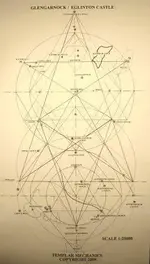You Would Not...Lose Your Footing...With This As A...Foot Post!
You mentioned you found this near...Peters Creek, PA.
This possible Foot Stone may be connected to the mysterious "Peters Creek Obelisk" which was found there and moved.
It is said that this Obelisk is 14 feet high and 6 inches square.
I wonder if this may have been the Foot Stone for this Mysterious Obelisk?
Hike along Montour Trail leads to startling discovery
DAVE ZUCHOWSKI /
OCT 8, 2009
7:00 AM
In mid-August, Finleyville resident Larry Gallant decided to veer off the well-traveled Montour Trail by taking a neglected side path.
"The trail is only about a foot wide and not very often used," said Mr. Gallant, a historian and member of the Peters Creek Historical Society.
The path rose up hill to a bluff, and when Mr. Gallant approached Peters Creek, he came across a rather startling sight -- a monolith that he believes could weigh as much as a ton and once stood on top the bluff but either tumbled or was dragged 23 feet down the embankment.
"The base of the stone sticks two feet out of the ground with another four feet embedded in the creek bed," he said. "Another eight feet of the obelisk, which comes to a point, lies in the creek."
Mr. Gallant is an avowed cultural diffusionist, meaning he adheres to the theory that a vast, world-wide advanced civilization existed in ancient times and that interactions between cultures across the oceans were commonplace.
"Ancient monuments and engravings abound across this [region of] land, but, being controversial, are ignored by academic scholars," he said. "Objects like the one I found are usually astronomical, religious or sacrificial in nature."
Mr. Gallant believes his find could prove to be very important because he said there's nothing in southwestern Pennsylvania that has similar features.
However, in the central part of the state, Huntingdon once boasted a similar obelisk and the town was, at one time, called Standing Stone.
Jennifer Stahl, executive director of the Huntingdon County Historical Society, wrote a brief about the stone, saying it was erected by Native Americans. Early pioneers John Harris, founder of Harrisburg, and translator Conrad Weiser are reputed to have seen it.
"Harris described it as being 14 feet tall and six inches square," she wrote. "The probable site of the stone was on the south side of Allegheny Street close to the west side of Second Street."
The stone disappeared around 1754, when Native American lands around Standing Stone were purchased by the state and opened to settlement. A replica was erected on the site but later moved in front of the courthouse, and it was eventually vandalized and destroyed. In 1898, a third stone was erected on the courthouse site to celebrate Huntingdon Borough's centennial.
"Standing stones are commonly found in the United Kingdom, Europe and Scandinavian countries," Mr. Gallant said. "In Britain, the sites are strewn with bones or shards of pottery, which can be carbon dated. In they United States, similar sites exist only in the Northeast and are under constant study, but important finds like Mystery Hill in New Hampshire still exist."
Currently called "America's Stonehenge," Mystery Hill is in Salem, N.H., about 40 miles north of Boston, and has functioned as a museum for the past 51 years.
"The major complex of stone structures -- stone chambers, tombs and a large 9-by-6-foot, bell-shaped table that weighs approximately 41/2 tons, occupy about an acre of land," spokesman Dennis Stone said. "Other monoliths thought to have astronomical properties cover an additional 20 acres."
According to Mr. Stone, there are more than 800 similar sites in New England and more than 50,000 megalithic sites across Europe, with 2,000 of them located in Ireland alone.
"Everyone's heard of Stonehenge, but there are many other similar sites in Europe as distant as the Black Sea," he said. "Before development removed some of them, there were about 60,000 sites similar in size, shape and orientation to the heavens in Korea. Others can be found in places as diverse as India and Colombia, South America. I wouldn't be surprised if the obelisk recently found along Peters Creek is an indication of another possible site."
Coincidentally, according to Mr. Gallant, a large mound created by the Adena peoples once stood at the mouth of Peters Creek. Copper artifacts recovered from that mound in 1890 had been displayed for several years at the Fort Necessity Museum.
Lawren Dunn, museum curator, said the two copper breast plates found at Peters Creek were a part of a collection of mound builder tools that were returned to their owner, Noah Thompson, in 1964.
"This suggests a possible link between the Adena culture and the standing stone," said Mr. Gallant, who would like to have the site excavated, but because it's located along the popular Montour Trail, he is concerned about the possibility of vandalism.
"Harris described it as being 14 feet tall and six inches square," she wrote.














